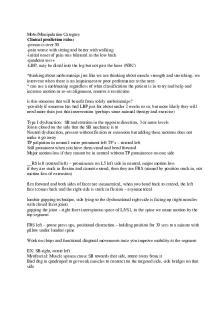Lecture notes, lecture reprocution PDF

| Title | Lecture notes, lecture reprocution |
|---|---|
| Course | Physiology Of The Human Body |
| Institution | University of Manitoba |
| Pages | 4 |
| File Size | 87.2 KB |
| File Type | |
| Total Downloads | 101 |
| Total Views | 181 |
Summary
Download Lecture notes, lecture reprocution PDF
Description
+February 3rd 2014 Stress
Any extreme external or internal stimulus eg surgery, infections, strong emotions, exams Triggers set of body changes called General Adaptation Syndrome All co-ordinated directly or indirectly by the hypotalmus ( bossof endocrine system)
Phases of Stress 1) Phase 1: Alarm reaction (fight or flight response) o Immediate = NS CNS (sensory input –detect change)
Hypothalmus (RAS therefore increase alertnas)
SNS
Organs
adrenal medulla
(discussed previously) E + NE (Prolongs fight or flight response) o
Effects of SNS + endocrine: a) Increase blood glucose SNS inhibits insulin release E, NE converts glycogen to glucose (in liver) b) Increase HR, force of contraction c) Increase resp rate d) Decrease blood flow to skin + abdominal viscera Therefore more available for skel. + card.m, + brain( O2 + glucose to working organs)
e) Decrease in digestion and urine production 2) Phase 2: Resistance Reaction Long term Endocrine Permits recover from the effects of 1) (alarm phase) (tissue repair, etc) or response to longer term stress(e.g. starvation) Hypothalamic hormones initiate 2): Hypthalmus Growth Hormone releasing hormone (GHRH)
Corticotrophin Releasing hormone (CRH)
ANT pit Adrenocorticotropic hormone (ACTH)
Growth Hormone (GH)
Adrenal Cortex
Cortisol (glucocorticoid)
GH a) Stimulates growth (protein production), cell reproductions Cortisol a) Releases in 30 sec of a stress but response not for hours-steroid hormone-acts on nuclear receptors b) Inhibits insulin release Release of hormones causes: a) Increase blood glucose Liver stim, to produce new glucose from fats and later from proteins Little insulin (because of inhibition)- glucose not taken up well, esp by skelm (at rest) + adipose tissue. Therefore: i) Glucose spared for use by NS ii) Metabolism of non NS directed to use fats for energy (control: GH, cortisol) – if stress continues, cortisol inhibits GH release and then proteins also used iii) Overall: increase FA and AA energy (except brain) b) Inhibition of : immune system, bone formation, formation of CT (delayed healing) c) Release of aldosterone +antidiuretic hormone (ADH)
Reduces salt + water loss at kidney to maintain blood vol. Long term effects Decrease weight, increase bp, increase hr, immune suppression (cortisol), decrease bone density, increase risk of type two diabetes (because increase blood glucose) 3) Phase 3: Exhaustion Result from: a) Depletion of body resources ie lipid reserves b) Loss of potassium (aldosterone effect) c) Damage to organs (heart, lover, kidneys)
Male Reproductive Hormones
After Puberty Hypothalamus:
Gonadotropin Releasing Hormone (GnRH)
Anterior or Pituitary
LH (luteinizing hormone)FSH ( Follicle stimulating hormones)
Testes
Testosterone (leydig cells)
Spermatogenesis (in seminiferous tubules)
Functions of Testosterone: 1) Development of organs of reproductive tract + secondary sex characteristics 2) Stimulates bone growth at epiphyseal plate (converted in bone to Estrogen to stop growth = closure of plate) 3) Promotes protein anabolism 4) Directly stimulates spermatogenesis
Female Reproductive Hormones (27.22) After puberty Hypothalamus:
Gonadotropin releasing hormone (GnRH)
Ant pit
LH
FSH
Ovaries
ovulation
follicles develop (primary secondary)
Estrogens...
Similar Free PDFs

Lecture notes, lecture 3
- 5 Pages

Lecture notes, lecture Subspaces
- 21 Pages

Lecture notes, lecture 14
- 3 Pages

Lecture notes, lecture 6
- 3 Pages

Lecture notes, lecture 7b
- 4 Pages

Lecture notes, lecture 13
- 12 Pages

Lecture notes, lecture 12
- 9 Pages

Lecture notes, lecture all
- 62 Pages

Lecture notes- Lecture 1
- 20 Pages

Lecture notes, lecture Logarithms
- 13 Pages
Popular Institutions
- Tinajero National High School - Annex
- Politeknik Caltex Riau
- Yokohama City University
- SGT University
- University of Al-Qadisiyah
- Divine Word College of Vigan
- Techniek College Rotterdam
- Universidade de Santiago
- Universiti Teknologi MARA Cawangan Johor Kampus Pasir Gudang
- Poltekkes Kemenkes Yogyakarta
- Baguio City National High School
- Colegio san marcos
- preparatoria uno
- Centro de Bachillerato Tecnológico Industrial y de Servicios No. 107
- Dalian Maritime University
- Quang Trung Secondary School
- Colegio Tecnológico en Informática
- Corporación Regional de Educación Superior
- Grupo CEDVA
- Dar Al Uloom University
- Centro de Estudios Preuniversitarios de la Universidad Nacional de Ingeniería
- 上智大学
- Aakash International School, Nuna Majara
- San Felipe Neri Catholic School
- Kang Chiao International School - New Taipei City
- Misamis Occidental National High School
- Institución Educativa Escuela Normal Juan Ladrilleros
- Kolehiyo ng Pantukan
- Batanes State College
- Instituto Continental
- Sekolah Menengah Kejuruan Kesehatan Kaltara (Tarakan)
- Colegio de La Inmaculada Concepcion - Cebu





